FIA75 Part 2: Putting the International in FIA (1973-1997)
As we continue our journey into the next 25 years of airshow history, local historian and aviation enthusiast Peter Cooper shares some of his highlights from an incredibly transformative period for the air displays and trade exhibitions at Farnborough International.
Want a recap on the first 25 years? View the first blog here.
1974 – The First Truly International Show
1974 saw an increasing amount of overseas participation. The highlight of 1974 was undoubtedly the arrival of the Lockheed SR-71A Blackbird from its record-breaking flight between New York and London in just 1hr 55mins and 42secs, covering the 3,400 miles at an average speed of 1,817 mph. It then flew over the Netherlands to slow down and turn around for a full stop landing at Farnborough. To see this iconic aircraft touch down and stream its red brake parachute was a sight indelible in the brain. It was displayed in the static park all week, heavily guarded.
The prototype HSA Hawk T.1 was also shown at Farnborough for the first time and this aircraft was admirably flown by test pilot Duncan Simpson. Another Hawker Test Pilot, John Farley, flew the Company demonstrator, HS Harrier T.52A, attaining an extremely steep angle-of-attack as he climbed away from a vertical lift-off and then demonstrated a series of manoeuvres in normal and vertical flight including ejecting smoke into the jet efflux to show the pattern of the vectored thrust when the nozzles were turned. A nice touch!
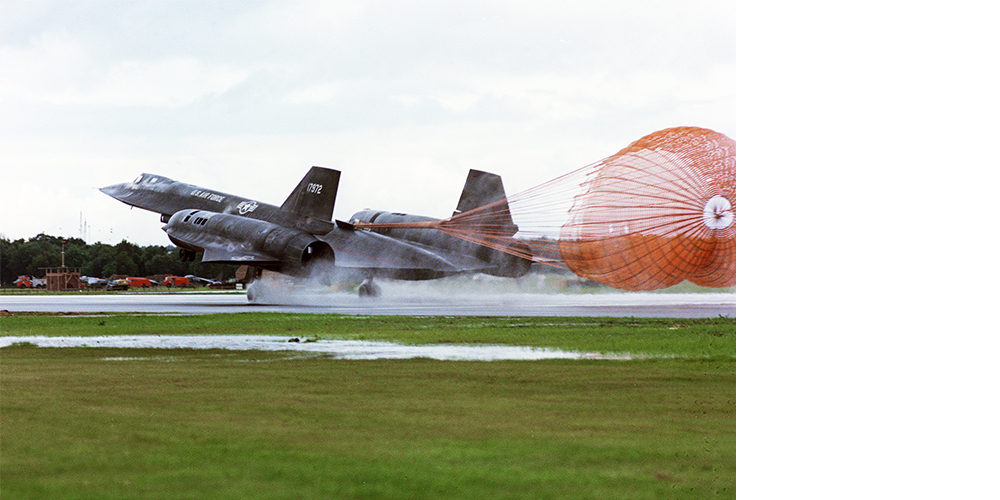
(The Lockheed SR-71A Blackbird, from 9 SRW Beale AFB, Ca, with parachute streamed, touches down on a wet Farnborough runway having just achieved the new speed record from New York to London. Image: FAST Archive)
1976 – Concorde Touches Down at Farnborough
The first UK built production BAC Concorde made its first Farnborough landing during the 1976 show and was statically displayed, with queues of attendees walking through the cabin area. A nice touch to allow an insight into the world of supersonic air travel.
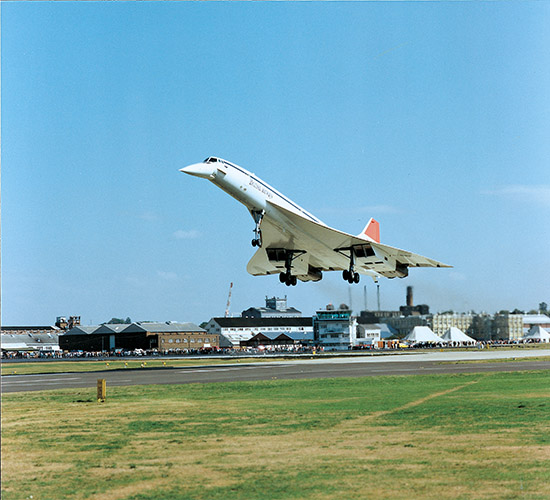
(BAC Concorde G-BBDG, the first UK production example, is about to touch down on runway 25 at Farnborough on 3 September 1976, arriving from Brize Norton. This was the first Concorde to land at Farnborough. Image: FAST Archive)
1978 – A Ski-Jump at an Airshow?
There was one item that was very different at the 1978 airshow and left a few gasps in the process. A special ski-jump had been built on the airfield, at a 15-degree angle, and this was used to launch the Harrier T.52A and a Sea Harrier FRS.1 into the air, utilising the powerful short take-off capability to hurtle the aircraft skywards.
By now the large airliners from Airbus were also coming on the scene and the Airbus A300B4 was thrown around the sky like a fighter - well almost - to show the agility of these new generation airliners that would soon flood the market.
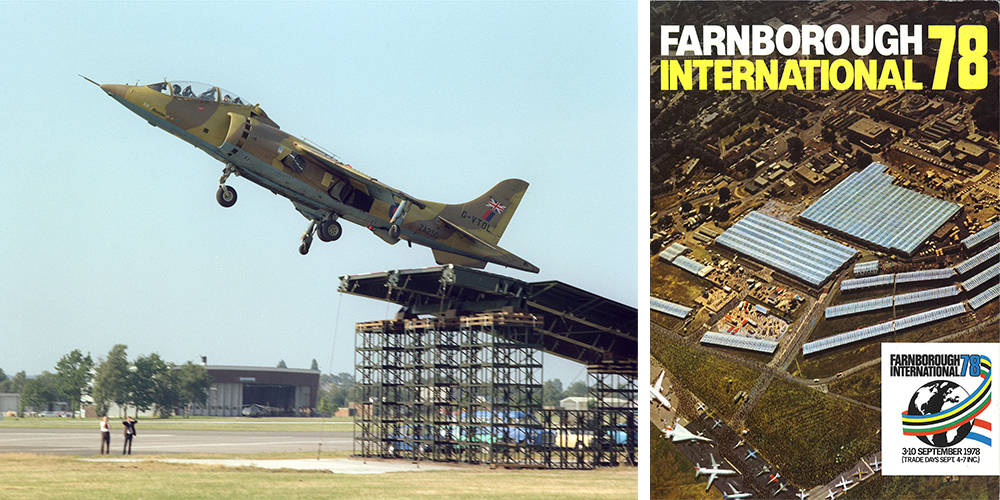
(Leaping skyward from the ski-jump assembled on Farnborough airfield, is the Harrier T.52 in the hands of Test Pilot John Farley, one of the highlights of the 1978 show. Image: FAST Archive)
1982 – 25th Show at Farnborough
The highlight of the 25th airshow held at Farnborough was undoubtedly the three-tone brown camouflage Rockwell B-1A (not yet called the Lancer) appearing for the first time. This example being a test aircraft from Edwards AFB, California, prominently displayed in the static park giving the world the chance to see this new strategic bomber close-up. This was the first time that the B-1 had been outside the USA.
Lockheed were also celebrating their 50th year and an example of the secretive TR-1 was statically displayed alongside a Lockheed 10A Electra of the 1930s.

(Rockwell B-1A departs from runway 25 at Farnborough heading back to Edwards AFB California, after being statically displayed at the 1982 show. Image: FAST Archive)
1986 – Fast Jets Rule the Skies at Farnborough
1986 saw the British Aerospace Experimental Aircraft Programme (EAP) take to the Farnborough skies for the very first time. This was the advanced technology demonstrator for the European Fighter Aircraft (EFA) that eventually led to the BAE Eurofighter Typhoon, which is the cutting-edge combat aircraft still in service today. Two new jets, the Dassault Rafale and the BAE EAP also gave individual displays and, as expected, cavorted around the sky in reheat showing off agile turns and climbs, accompanied by loud decibels.
Last but not least was another appearance of a Lockheed SR-71A Blackbird of the 9 SRW, from RAF Mildenhall, only this time it flew. There were no tight turns or climbs here, it just roared along the display line in after-burner making lots of noise and using a large turning circle to bring the aircraft back to the display line. Awesome stuff this was.
1992 – Farnborough Firsts Continue to Shine
The Airbus A340 was showcased at Farnborough for the first time in 1992. It gave a delightful display of agility, climbs and turns that really defy an airliner of this size.

(Making a hi-alpha pass is the Airbus A340 demonstrator and is seen here during its stunning Farnborough debut during the 1992 show. Image: Peter J Cooper)
British Aerospace had 125s, 146s, Jetstreams and ATPs on show, but the three-ship formation of an RJ70, RJ85 and RJ100 was a sight to behold. The BAe 146 in the guise of an RJ100 (Regional Jet) broke away from the RJ formation to give an individual display of its quietness.
Military hardware on display included the F/A-18, L-59, AJ-37, JAS-39A, F-15 and F-16, Harrier and Tornado. The flying displays given by the Saab JAS-39A Gripen and the Dassault Rafale were powerful demonstrations of ability and performance.
The black overall Dassault-Breguet Rafale C prototype gave a very powerful demonstration at the 1992 show, showcasing its capability as a future multi-mission attack aircraft for the French Air Force.
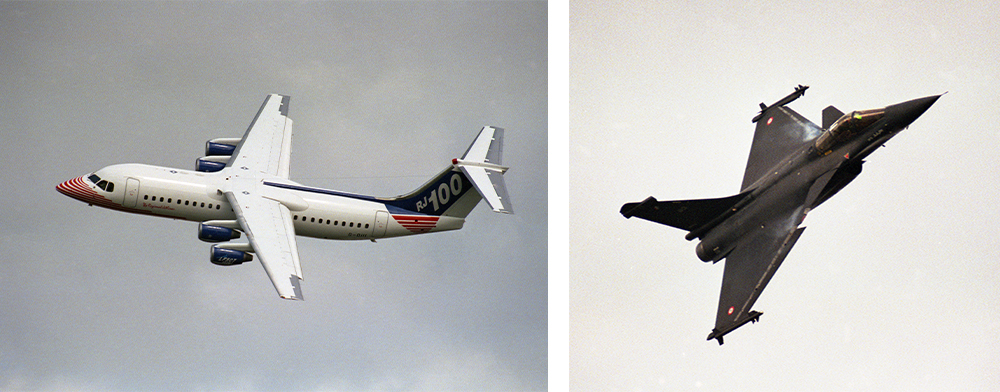
(Left Image: Breaking off from the three-ship BAE RJ formation is the Regional Jetliner RJ100, the longest of the type, seen banking over Farnborough during the 1992 display. Image: Peter J Cooper)
(Right Image: The all-black Dassault-Breguet Rafale C prototype gave a spirited display at Farnborough 1992. This was the variant that eventually served with the French Air Force as a multi-role fighter. Image: Peter J Cooper)
1994 – The Return of a Historical Icon
One of the highlights from 1994 came on the last day of the show, when a replica Vickers FB27 Vimy bound for Australia departed from Farnborough. This was heralded by a flypast from a Qantas Boeing 747-438 which had taken off from Heathrow.
British Aerospace also put up a formation of 14 Hawks, in the new overall black scheme, to celebrate the success of the type with deliveries to 14 air arms.
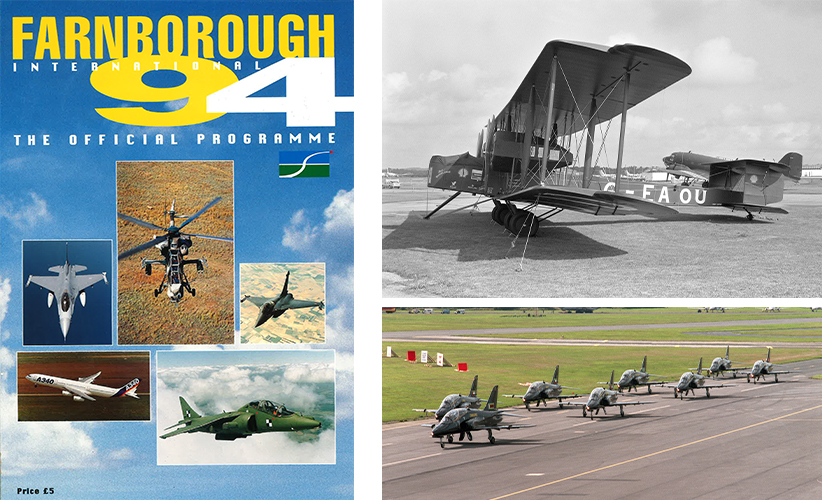
(Top-Right: The superb replica Vickers FB.27 Vimy, 'Spirit of Brooklands' is seen tied down in the static park during the Farnborough 1994 show. It departed on its epic journey to Australia on the last day of the show. Image: Peter J Cooper)
(Bottom-Right: Eight BAe Hawk T.1s are seen here taxying for take-off at Farnborough during the 1994 show. They were joined by six others to make up to fourteen aircraft, depicting the number of Air Arms that were ordered. Each aircraft had the country’s flag on the tail and name on the fuselage. Image: FAST Archive)
1996 – Airliners Dominate the Show
The Northrop-Grumman B-2A Spirit, stealth bomber, performed a fly-by on the opening day at the 1996 display, operating directly from its base in the USA. For many this was the first time this type had been seen after hearing so much about it in the press.
The Eurofighter, what was later named the Typhoon, made its debut appearance at Farnborough, still in prototype form but would ultimately become the mainstay of the RAF’s combat air defence.
However, airliners seemed to dominate the show as there was an Airbus A319-114, A330-332 and A340-311 all involved in the flying display. Boeing were also involved with their 777-200, displaying in the static area for the first time. Although they were not full of passengers and were only lightly fuelled, the aerial ballet and gracefulness of how the pilots handled these large airliners was truly inspiring and awesome to watch.

(Boeing 777 Prototype commences its take-off roll along the Farnborough runway for the 1996 show. This example first flew on 12 June 1994, and is now preserved at the Pima Air and Space Museum, being last operated by Cathay Pacific Airlines. Image: Peter J Cooper)
End of an era and new beginnings
This era saw a boom in trade as orders for aircraft and equipment soared. This totalled a massive US$26.7 bn in 1996 which exceeded all expectations. This show was also the last to be held in September as the show would move to July in the editions to follow.
The end of this period also saw big changes for aviation in Farnborough with the MoD announcement that they no longer required the airfield. Plans for Farnborough’s future as a business aviation centre were therefore fully underway and would excel in the decades to come.
Check out the final instalment of our blog series, Pioneering the Future (1998-2023).
Do you have a favourite memory you’d like to share?
Get involved on our social media channels and tag Farnborough International Airshow in your posts so we can share your memories too!
Use the hashtags #FIA75 and #FIAmemories.